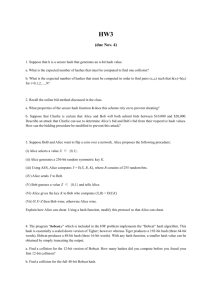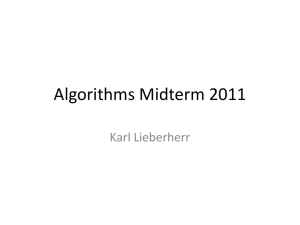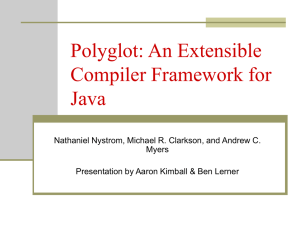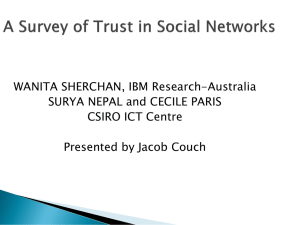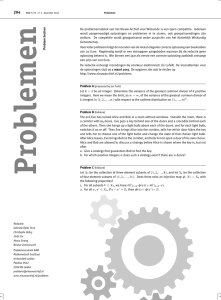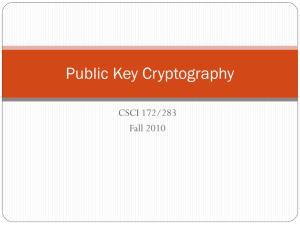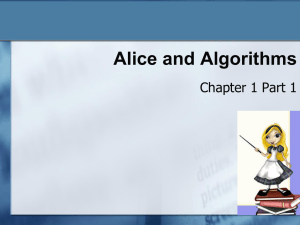Secure Hash Functions
advertisement
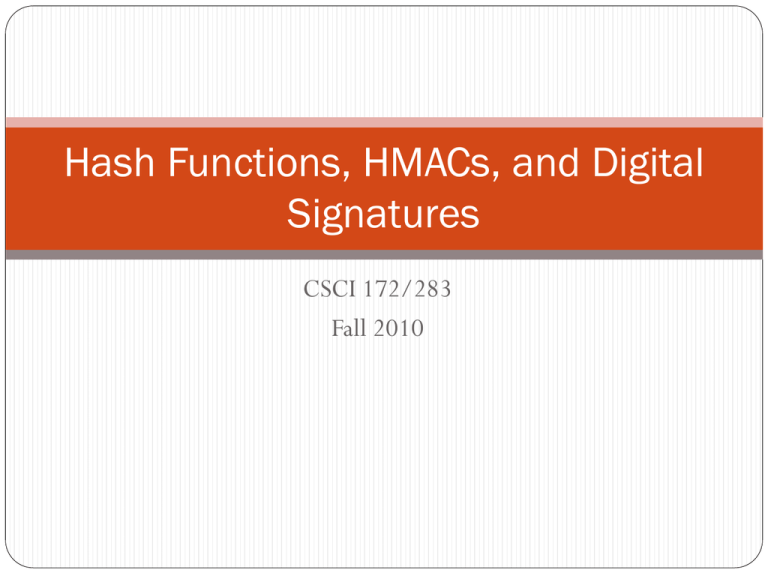
Hash Functions, HMACs, and Digital
Signatures
CSCI 172/283
Fall 2010
What ciphers do
Encryption ciphers
Provide confidentiality
Eve can’t see what Alice and Bob are saying
Can Eve do anything?
C= Encrypt(M)
?
Alice
Bob
Eve
What ciphers don’t do
Suppose Eve can get between Alice and Bob
What if Eve can manipulate the data?
I’ll send
Bob M
Alice sent
me M’
How can Bob tell if Alice’s
message
wasfor modified?
Now
a
M
few changes
M’
Alice
Bob
Eve replaces M with M’
Eve
Hash functions
Map a variable length message to a fixed length message
y = h(x)
If h is a 64-bit hash function, then y always fits in 64 bits
0 ≤ y < 264
Actual hash value may be represented with fewer bits, since 0, 1, etc. are
in the output range
Should include leading zeros
Pigeonhole principle
If n+1 pigeons nest in n holes, at least one hole has more than one
pigeon
Maybe each hole has one pigeon, except for one that has two
Maybe all the pigeons are in the same hole
Was the message modified?
Alice sends Bob {C = Encrypt(M), h(M)}
When Bob gets {C, h(M)} , he checks
M’=Decrypt(C)
Bob computes h(M’)
h(M) = h(M’)?
If Eve modifies the message, it probably won’t match
If it does match, assume that it is the message Alice sent
What could go wrong?
Suppose h(x) maps to 1 or 0 with equal
Nice try!
probability?
Eve has a 50/50 chance of fooling Bob
Suppose h(x) does not map to the entire
range with equal probability
Forget about the encryption for a moment
What could Eve do? Suppose:
Eve can calculate f(h(M)) = M
Eve knows some M’, h(M’) = h(M)
We need some properties
Eve repeatedly just tries random
modificationsthat provide security!
Cryptographic hash functions
When security people talk about hash functions, they mean
cryptographic (or secure) hash functions
These should provide
Collision resistance
Difficult to find any M, M’≠ M s.t. h(M) = h(M’)
Preimage resistance
Given h(M), difficult to find M’ s.t. h(M’)=h(M)
Second preimage resistance
Given M, difficult to find M’ s.t. h(M’)=h(M), M’≠M
If a hash function h does not meet these requirements…
But what does it all mean?
If h is secure
Easy to compute in one direction
Very difficult to compute in the other direction
Computationally infeasible
i.e. your grandchildren’s grandchildren’s grandchildren will be long gone
before that computation finishes
Very difficult to find two messages that hash to the same value
Can anyone name any?
Secure Hash Algorithm (SHA)
NIST standards
Mandatory in US Government
Adopted globally
SHA (SHA-0) is no good anymore
SHA-1 has attacks and is not recommended
SHA-2 looks good for now
What happens when there’s an attack?
It takes years to create and analyze functions
SHA-3
About halfway through the process of choosing the next SHA
family of hash functions
International competition
64 submissions
Round 1: 54
Round 2: 14
Round 3: ~5
And the winner is… ?
Winner gets massive bragging rights
A lot of new design techniques
A lot of new attack techniques
Who can compute a hash?
A hash is a keyless algorithm
Anyone can compute h(x) if they know x
Eve could replace M with M’ and h(M) with h(M’)
The hash matches what Bob computes, so he assumes that Alice
sent him M’
How could we stop Eve from doing this?
HMAC
Hash-based Message Authentication Code
Keyed hash
y = HMAC(M, k)
Provides some level of authentication
If only and Alice and Bob know the key and the HMAC is correct, it
must have come from one of them
Can make an HMAC algorithm from an unkeyed hash algorithm
Why not just make a keyed hash algorithm?
Import/export restrictions
Keyless algorithms are not restricted
How to key an unkeyed hash
We have hash function h, which processes a message in b-byte
blocks
Let k be a key, |k| ≤ b
Pad k with zeros to form k’, |k’| = b
Let ipad be 00110110, repeated b times
Let opad be 01011100, repeated b times
HMAC-h is formed by
HMAC-h(k,m) = h(k’ opad || h(k’ ipad || m))
Who sent it?
For HMACs, the key is shared
Fine for some applications
What if instead of knowing if someone who knows the key
sent it, we want to know that Alice sent it?
Digital signatures
Use public key cryptography
Recall that only Alice knows Alice’s private key
Alice digitally signs her message, M
Alice computes h(M)
Alice encrypts h(M) using her private key (signing)
Alice sends Bob {M, Enc(h(M), Apriv)}
Bob verifies the message was sent by Alice
Computes y’ = h(M)
Decrypts Enc(h(M), Apriv) with Alice’s public key
y = Dec(Enc(h(M), Apriv), Apub)
Does y’ = y?
If yes, Alice must have sent it
Digital Signatures
Digital signatures provide checks for integrity and origin
Because only Alice knows her private key, it must have been
her that sent it
Non-repudiation
Suppose Alice wants to encrypt M so that Eve can’t see it
Should she:
Encrypt, then sign
Sign, then encrypt
Does it matter?
Why?
Conclusion by xkcd
http://xkcd.com/177/
